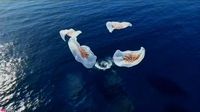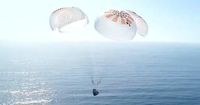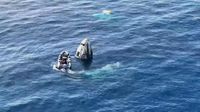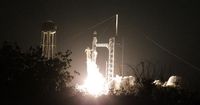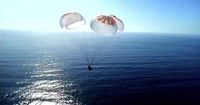On Friday, April 4, 2025, a SpaceX Crew Dragon capsule carrying four adventurers splashed down in the Pacific Ocean off the coast of southern California, completing the first crewed flight around Earth's poles. The Crew Dragon "Resilience" fired its braking rockets at 11:26 a.m. EDT and re-entered the atmosphere about 25 minutes later. Enduring heat shield temperatures up to 3,500 degrees Fahrenheit, the spacecraft rapidly slowed down, deployed four big red-and-white parachutes, and settled to an on-target 16 mph splashdown at 12:19 p.m. EDT.
SpaceX crews deployed nearby rushed to the gently bobbing capsule and rigged it for a lift onto the company's recovery ship Shannon. In the first test of its kind, the crew exited the craft on their own, demonstrating the ability to get out of a Crew Dragon without help from recovery crews. Unlike missions to the International Space Station, where astronauts are carried out of their capsules, mission commander Chun Wang and his three companions were able to lift emergency gear up and out of the hatch before climbing out themselves.
Chun Wang, a Chinese-born citizen of Malta who lives mostly in the extreme north of Norway, met his crewmates—Norwegian cinematographer Jannicke Mikkelsen, German robotics specialist Rabea Rogge, and Australian polar guide Eric Philips—on Svalbard, a Norwegian archipelago in the Arctic Ocean. "We ... all met on Svalbard, and we love the ice," Chun posted on X during the flight. "The mission was planned when I lived there, and we fly polar because, in an ISS-like orbit, we are unable to see where we live. From this perspective, the mission has perfectly achieved its goal."
Before launch, Chun expressed his intention to look for Antarctic research stations. However, Mikkelsen noted during the flight that from 460 km above, it is only pure white, with no human activity visible. The Crew Dragon is highly automated and can be controlled from the ground when necessary. SpaceX viewed the Fram2 flight as a stepping stone toward opening the door for more non-professionals to fly to orbit.
Chun Wang chartered Resilience for the trip to polar orbit, marking SpaceX's third privately funded civilian space tourism flight. The mission was named Fram2 in honor of a 19th-century sailing ship—Fram, or "forward" in Norwegian—that carried Arctic explorers to the poles. A small piece of the original ship's teak decking was carried into space aboard the Crew Dragon. "My own journey has been shaped by lifelong curiosity and a fascination with pushing boundaries," Chun said before launch. "As a kid, I used to stare at a blank white space at the bottom of a world map and wonder what's out there. Curiosity eventually took me across the continent and to the southernmost tip of Earth in 2021, and also the North Pole in 2023. ... Fram2 isn't just about going to space. It's about pushing boundaries, sharing knowledge ... and we hope our mission will further inspire later people to do the same."
The crew planned to carry out 22 experiments during the flight, ranging from filming auroral displays from orbit to testing compact exercise equipment for use in smaller spacecraft, growing oyster mushrooms in microgravity, and taking the first X-rays in space. Along with three high-end professional cameras, the crew was equipped with multiple laptops and tablets, a ham radio, and even an X-ray generator to capture the first-ever X-ray image of the human body in space—something crucial for future long-duration missions to Mars and beyond, Chun posted on X.
Throughout the flight, the crew posted spectacular videos, including a timelapse view of Earth below as the Crew Dragon sailed over Antarctica all the way to the North Pole, making the trip from one pole to the other every 46 minutes. "Proud to be able to bring to space some incredible cameras and lenses capturing the first images of the Arctic and Antarctic shot by humans from space," Mikkelsen posted on X. Another video showcased the entire state of Florida and the southeastern United States, zooming in on the Kennedy Space Center, where Chun marveled, "there's our launch pad. Oh my God!"
The Fram2 mission, led by cryptocurrency billionaire Chun Wang, was a novel endeavor that allowed humans to pass directly over the North and South poles for the first time. The mission launched from NASA's Kennedy Space Center in Florida on March 31, 2025, and included a unique orbit around Earth that allowed the crew to conduct various research projects, including capturing images of auroras from space and documenting their experiences with motion sickness.
Space motion sickness proved to be a significant issue for the crew, as Wang noted in a post on X, stating, "The first few hours in microgravity weren’t exactly comfortable. Space motion sickness hit all of us—we felt nauseous and ended up vomiting a couple of times. It felt different from motion sickness in a car or at sea. You could still read on your iPad without making it worse. But even a small sip of water could upset your stomach and trigger vomiting." Fortunately, by the second morning, he felt completely refreshed.
The crew shared a batch of images and videos captured from a bulbous window at the tip of the 13-foot-wide Crew Dragon capsule. Wang was surprised to see that Antarctica appeared "only pure white" and "no human activity (was) visible" from his vantage point aboard the spacecraft. Riding along with Wang were Mikkelsen, Rogge, and Philips, all of whom have ties to polar exploration.
Upon splashdown, the crew carried out an "egress experiment" to test their ability to exit the spacecraft on their own after returning to Earth. This was the first time a crewed SpaceX mission returned from space and splashed down off the coast of California, a significant change from previous missions that returned near Florida. SpaceX had moved its recovery operations to the Pacific to eliminate the risk of Dragon debris falling in random parts of Earth.
As the crew exited the Dragon capsule one by one, they demonstrated their ability to walk off the spacecraft unassisted, a crucial test that could inform future missions to the moon or Mars. "All four framonauts have safely exited Dragon unassisted," SpaceX stated. This mission not only marked a historic achievement in space travel but also provided valuable insights into human physiology in space, paving the way for future explorations beyond our planet.


